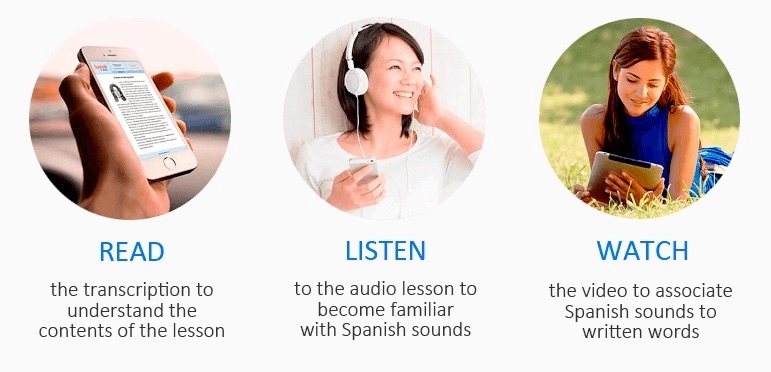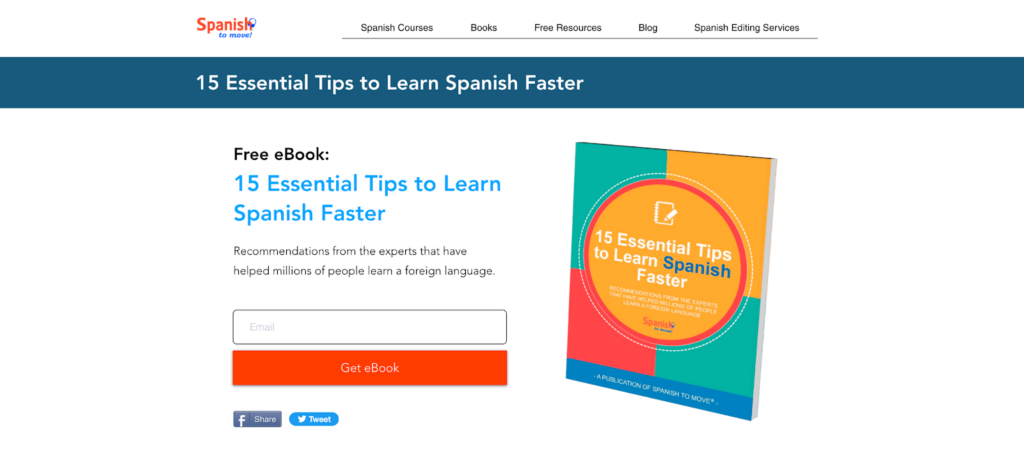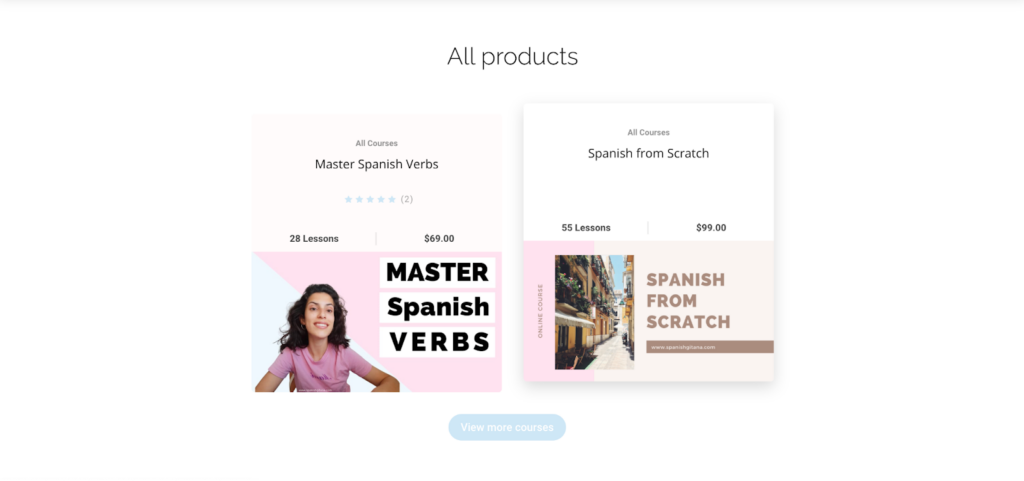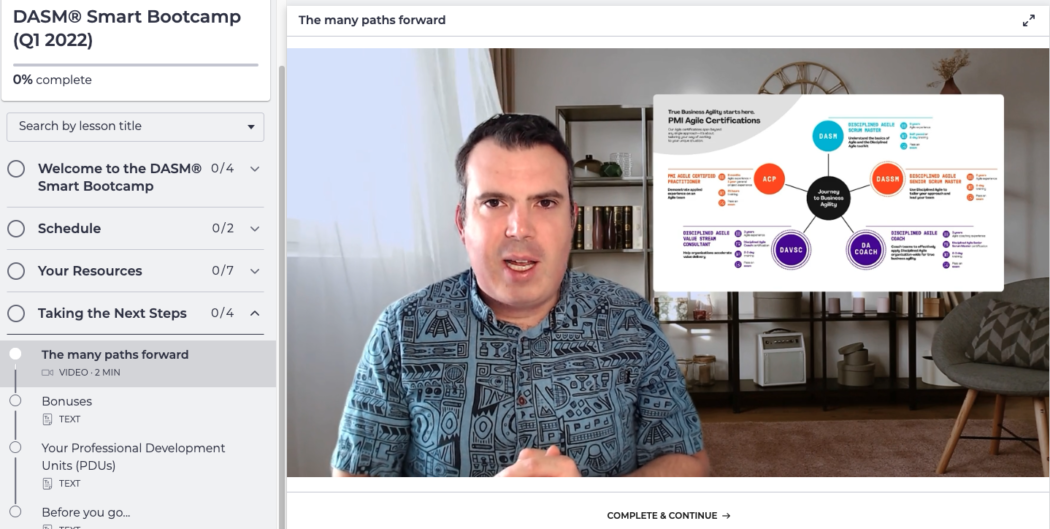The Spanish language is one of the most spoken languages in the world today. And in 2023, the ability to teach Spanish online has never been more accessible or rewarding.
In this comprehensive guide on how to teach Spanish online, we’ll walk you through why online education can be a rewarding experience, what you’ll need to start, and what makes an excellent online Spanish teacher. From there, we’ll share five detailed steps you can take to start teaching Spanish online today.
Skip ahead here.
- Why teach Spanish online?
- What you need to teach Spanish online
- What makes a good online Spanish teacher?
- Getting started as an online Spanish teacher: 5 steps
- Final thoughts
- FAQs about teaching Spanish online
Why teach Spanish online?
According to Meticulous Research, the online language learning market is set to reach $31 billion by 2030, up significantly from $7.4 billion in 2022. As the demand for learning Spanish soars, teaching it online has become a lucrative and fulfilling endeavor. The advantages of online learning offer real benefits for teachers and their students.
Here are just a few of the many benefits of teaching Spanish online:
- Flexibility – Whether you’re looking for a full-time or part-time gig, choose your own working hours.
- Global reach – With online learning, you aren’t limited by how far you can drive. You can work with students from across the globe.
- Cost-effectiveness – Save on gas, commute time, teaching materials, and more when you switch to teaching online.
- Accessibility – Online learning makes learning more accessible for those who don’t have time to commute, can’t attend in-person instruction, or don’t have the means to hire private tutors.
- High demand – Spanish is spoken by nearly 493 million people across the globe and is the world’s second most spoken language. As the online language learning market grows, so will the demand for Spanish educators.
- Instant feedback – Using real-time quizzes, tests, and assessments, you can give your students immediate feedback, saving you time and helping them learn at a pace that fits their needs.
Still not sure if teaching Spanish online is right for you? Here’s what Amanda, an online educator with over 400 students, says about getting started.
“We all have a gift that someone needs,” she says. “Don’t let technology, imposter syndrome, or any other limiting beliefs scare you. Just put yourself out there and get started because you can always perfect yourself as you go. If you don’t get started, then you’ll never know.”
What you need to teach Spanish online
There are few requirements to teach Spanish online. You can begin teaching without a formal education or background in teaching; all you need is access to a computer with internet, a microphone and/or camera, the ability to speak Spanish fluently, and a passion for teaching.
That’s it! If you have all those things, you can begin teaching Spanish online.
The next step is to determine how you’d like to teach. Would you like to become a one-on-one tutor? Teach small cohorts? Or, offer a digital course for a much larger group of students? The possibilities are endless, but determining how you’d like to teach will inform your decisions about what platform to start teaching on (more on that later).
Before diving into the five easy steps to start your online teaching journey, let’s look at what makes an excellent online Spanish teacher.
What makes a good online Spanish teacher?
While there are only a few technical and educational requirements to be an online Spanish teacher, you’ll need a few additional qualities to be an excellent educator.
- Clear communication – Fluency in Spanish is one thing. To teach Spanish effectively, you must communicate clearly in English, avoiding any confusion with your students.
- Time management – If you work synchronously with students, you must manage live lessons, activities, and office hours accordingly.
- Support and encouragement – Learning a new language is challenging. Your students will struggle at some point in their learning path and need your support and encouragement to keep going.
- Cultural awareness – No Spanish course is complete without a cultural element. Like all languages, there are unique cultural norms and practices that accompany language. Teaching these nuances is an integral part of online Spanish education.
- Tech skills – Regardless of which platform you choose for your online teaching business, you’ll need some technical skills. Spanish teachers will have to host classes, upload videos, and create digital downloads for their students.
Ready to get started as an online Spanish teacher?
Getting started as an online Spanish teacher: 5 steps
Now that you understand what you’ll need to make it as an online educator let’s dive into the step-by-step process. Here are five steps that will take you from asking, “How to teach Spanish online?” to an online educator with a thriving business.
The first step in getting started as an online Spanish teacher is identifying the best platform for your online course business.
The platform you choose will be the home base for all your operations, whether that includes student communication, hosting synchronous classes, or uploading asynchronous courses. The goal is to find a platform that can accommodate your needs both now and in the future.
We’ve compiled a list of the best online education platforms, but before opening up a bunch of tabs in your web browser, we’ve gathered a list of the features you should pay attention to in your search.
- Course creation – Look for a platform that offers easy-to-use course creation tools. This likely includes drag-and-drop editors and course templates.
- Student management – A good platform will help you manage student enrollment, track their learning progress, and complete administrative tasks with ease.
- Payment integration – The best online course platforms will offer a variety of payment gateways. The more options you can provide, the more likely you are to convert customers. Look for native payment gateways and integrations like Stripe and PayPal.
- Content security – Your digital products are, well, a product. So, select a platform that values your digital content and protects it from unwanted sharing, downloads, and redistribution.
- Community features – Features like discussion boards, group chats, and community forums can help you foster community and grow your business even faster. As a bonus, you can make the online learning environment a little less lonely for your students. Thinkific offers monetizable private communities, perfect for your Spanish learners to connect with one another.
- Multimedia support – Online learners expect their content to be delivered using various formats like text, video, and imagery. You might also include downloadables like workbooks or worksheets.
- Assessment and quizzes – Whether you’re offering certification or simply tracking student progress, assessments and quizzes allow you to ensure students are actually learning. And if they aren’t, you can use these to inform where and how to make changes in your offering.
- Certification generation – In conjunction with assessments and quizzes, automatic certification generation can make rewarding your students for course completion easy. This is also essential if you’re looking to sell to corporate or education-based clients.
- Analytics and reporting – Like assessments, analytics and reporting help you track student progress. Understanding when, where, how, and how often students engage with your course can give you valuable insights into how they learn and cater your offering to them.
- Multi-device support – Creating a professional-grade course for a web browser is one thing. Optimizing that same course for mobile users is an entirely different challenge, so look for platforms with tools to help you do just that. As a bonus, look for platforms that offer mobile apps. These apps will deliver an unparalleled mobile experience.
- Customer support – Despite our best efforts, sometimes tech just doesn’t work how we want it to. Some platforms only offer chat support, while others provide a range of support based on the plan you choose. Select a platform with support options that fit your needs and comfort level.
- Marketing tools – Unless you currently have a massive following or student base, you’ll need to market your course. If you currently use marketing tools, will they integrate with your platform of choice? And if not, are native options available?
With these 12 features to consider, let’s focus on some of the best online course platforms.
| Platform | Pros | Cons |
| 1. Thinkific |
|
|
| 2. The Leap |
|
|
| 3. Udemy |
|
|
| 4. Skillshare |
|
|
| 5. Teachable |
|
|
Still looking for the perfect platform? Here’s the complete list of the top online teaching platforms.
Once you’ve selected the perfect platform for your online course, it’s time to start creating Spanish lessons.
The first step in creating your lessons is developing your curriculum.
Write your online curriculum
Your online curriculum is the roadmap that explains what you’ll teach and how. It includes the topics and content you’ll cover, the outcomes you’ll use to measure success, teaching materials and resources, and more.
Public schools are typically required to use an accredited curriculum. But unless your target market requires certain learning outcomes or a specific curriculum, this part is entirely up to you.
Consider your target audience and their objectives as you write your curriculum. Ask questions like:
- What is the educational background of my target students?
- What are their professions?
- What proficiency level can my students currently speak Spanish at?
- Do my students have prior experience learning a second language?
- Are my students looking for certifications or casually learning?
- Do my students want group or community-oriented learning or individual learning?
- How much time can my students commit to learning each week?
- What kind of devices will students access my material?
Answering these questions as you draft your curriculum will help you create a student-focused course. Once you know what, how, and when you’ll teach, you can create your lesson content.
Create your lesson content
Your curriculum defines where your students start and end their educational journey with you. Your course content is the steps they take from start to finish.
For example, if your students are just beginning to learn Spanish, you might create lessons covering basic vocabulary, simple sentence structure, and grammatical patterns.
As you outline the lessons in your course, consider how you’ll deliver the course content, too. Will you use videos, infographics, diagrams, presentations, or some other form of delivery?
Luis Pelayo, Thinkific user and co-founder of Spanish To Move, uses text, audio, and video in his course lessons.
According to him, “You have to read the text to have an idea of what is being said in Spanish, then you have the audio to get used to Spanish pronunciation sounds, and you have a video with simultaneous translation into English, like the subtitles of a movie…it’s a new approach to learning a language.”

Create exercises and activities
In addition to receiving the educational material, your students must practice and implement their new skills. Exercises and activities allow you to create experiences for your students to do just that.
Use audio, group discussions, and interactive quizzes or games to deliver engaging exercises and activities.
Regardless of the online platform you select, you’ll need to market your online Spanish courses to attract students. Here are the four marketing strategies you should implement to drive students to your online course.
Social media marketing
In 2023, social media marketing is non-negotiable. However, that doesn’t mean you must build a presence on every platform. Instead, start your social media marketing strategy by choosing one or two platforms to focus on.
Use your data on your target demographic to inform your platform choices. But, consider using YouTube, Instagram, or TikTok, as these platforms are best for on-platform learning and video content.
Once you’ve selected a platform or two to focus on, create social content that engages your target audience, encourages community interaction, and offers value. The goal is to grow your audience so that more and more potential learners become aware of your online course or other offering.
Email marketing
Users on social media platforms like TikTok and YouTube get banned all the time. But unlike social media channels, email marketing is a channel you, and only you, own. This means your direct connection with your audience won’t magically disappear one day. And better yet, your performance isn’t subject to another company’s algorithm.
Email marketing allows you to deliver content directly to user inboxes and create automated and targeted email campaigns that nurture leads. To attract email subscribers, you’ll need to entice them to share their email with you in the first place. You can do this by offering gated content like ebooks, how-to guides, or webinars.
We recommend using tools like Mailchimp or MailerLite to get started. Just make sure your email marketing platform integrates with your online course platform.
Content marketing
Content marketing is when you create content designed to attract your target audience and familiarize them with your brand. Examples of content marketing include blog posts (like this one), how-to guides, ebooks, downloadable templates, and webinars.
Content marketing, like blog posts, often works with SEO marketing efforts, while content like how-to guides and ebooks often works with email marketing.
Like many creators, Luis Pelayo started teaching Spanish online without a content marketing strategy in place. It wasn’t until he began the Thinific 30 for 30 challenge that he created a free ebook called “15 Essential Tips to Learn Spanish Faster.” He promoted that lead magnet to drive signups for his email list, and in just 30 days, he doubled his goal of attracting 30 new students.

SEO
Search engine optimization (SEO) refers to the practice of optimizing digital content for search engines like Google. The goal of SEO is to make your content easy to find online.
SEO often includes keyword research, on-page SEO elements (meta description and headers), off-page SEO (backlinks), and technical SEO (site speed and mobile optimization). SEO is a valuable marketing strategy for all businesses, but it’s especially important if you create a website, landing pages, or social media channels for your business.
While SEO is a massive field to learn about, there are free, beginner-friendly courses that teach you the basics. The SEO Certification Course on Hubspot Academy is a great starting point.
Understanding how to price your online course is challenging but critical as you begin to market your course.
Start this fourth step in our five-step process of teaching Spanish online by conducting market research. Market research includes looking at competitor pricing and the perceived value of your course.
For example, are similar courses listed at $100 or $500? And, does your course teach beginners Spanish basics or take them from beginner to fluency?
Take the Spanish Gitana School, for example. Mariana, the owner of this online course business, features two distinct Spanish courses. One focuses solely on Spanish verbs, while the other targets beginner Spanish speakers. She’s priced the more comprehensive course, Spanish from Scratch, higher than the other verb-focused course.

You can create your pricing models once you estimate your course’s pricing. These include one-time payments, subscriptions, free trials, and course bundles. The more pricing models you can offer, the more likely your potential customers will be to convert.
As you consider various pricing models, double-check with your platform to ensure it can accommodate the models you’d like to offer. Platforms like Skillshare only offer subscriptions, while a platform like Thinkific offers one-time payments, subscriptions, and payment plans.
Knowing how well your online Spanish course is doing isn’t just a nice-to-have—it’s a must. By analyzing key metrics and listening to student feedback, you set the stage for continuous growth and improvement.
Zero in on the metrics you think are most important for your business. We recommend looking at key performance indicators (KPIs), student feedback, financial metrics, and educational outcomes.
At the end of the day, your online course is a digital product. And like any other product, consumers make purchases with a set of expectations. Whether they’re looking to learn for fun or achieve a specific level of mastery, your course should deliver the education it promises. Over time, by analyzing KPIs, student feedback, and educational outcomes, you can fine-tune your course.
Final thoughts
Learning how to teach Spanish online is only the first of many exciting steps in your journey as an online educator. Whether you’re looking for more control over your income, flexibility over your schedule, or autonomy in deciding what to teach, teaching online is full of opportunities and rewards.
Start your journey as an online Spanish teacher today. Sign up now to create and launch your first online course for free, without any transaction fees. With Thinkific, you’ll be able to develop online courses that cater to your students’ needs, whether that includes cohorts, one-on-one sessions, synchronous or asynchronous learning, or an on-the-go experience with Thinkific Mobile.
FAQs about teaching Spanish online
How can I teach Spanish online?
To begin teaching Spanish online, you can join an existing student-teacher marketplace or create your own online business, offering 1-on-1 tutoring, online courses, or a combination. Creating your own course or community on a platform like Thinkific allows you to control pricing, educational content, when and how you work, and more. Create and launch your course for free today!
Can I teach Spanish online without a degree?
You can teach Spanish online, regardless of your educational background. If you want to join a tutoring platform or agency, refer to their requirements. However, it is possible to market your own teaching business and take on students without a formal degree or certification.
Can you teach Spanish online full-time?
You can teach Spanish online full-time or part-time. Your work schedule is entirely up to you. Opt for a tutoring platform like Prepyly or Berlitz and work with limited students on a flexible 1-on-1 schedule. Or, create online learning material using a platform like Thinkific and work as much or as little as you want, leveraging evergreen online courses and optional teacher-to-student engagement.
Where could I find students to teach Spanish online?
Online Spanish teachers can find students in a variety of places. Teachers can tap into existing student markets on platforms like Lingoda or Skillshare. Or, teachers can market to and attract their own students using various marketing strategies, driving students to their online educational material on platforms like Thinkific.
Stuck creating a name for your business? Check out our free AI-powered name generator!
Or ready to start your online learning business? Check out Thinkific’s different plans here (we have a free tier 😏)







